Factors associated with human papilloma virus vaccine uptake before the health awareness, learning and education intervention in Korogocho Informal Settlements in Nairobi County, Kenya
Jared Otieno Ogolla1, David Rocaztle Masinde1 and Alexander Munyao Mbeke2
1Department of Public Health, School of Public Health and Community Development, Maseno University, Private Bag, Maseno, Kenya
2Department of Biological and Biomedical Sciences, School of Science, Laikipia University, PO Box 1100-20300, Nyahururu, Kenya
Abstract
The human papillomavirus (HPV) vaccine is a critical public health measure designed to reduce the incidence of HPV-related cancers, particularly cervical cancer. Despite its proven efficacy, vaccine uptake remains suboptimal in many areas, including Korogocho ward, a densely populated informal settlement in Nairobi County, Kenya. This study explored factors influencing HPV vaccine uptake among girls aged 9–14 in Korogocho. A total of 812 caretakers participated, identified through snowball sampling during the baseline survey of the Health Awareness, Learning and Education (HEALEDUC) intervention. The HEALEDUC initiative, a quasi-experimental study, employed intervention and control groups with pre- and post-intervention assessments to evaluate strategies for improving HPV vaccination rates in the region. Key findings revealed that caretaker age significantly impacted vaccination decisions (p = 0.022). Caretakers aged 35–44 were more likely to vaccinate their children (OR = 1.930, 95% CI = 0.790–4.716), although no consistent patterns emerged among other age groups. Interestingly, uncertainty about HPV transmission was associated with higher vaccine uptake (OR = 2.024, 95% CI = 1.107–3.701, p = 0.022). Negative perceptions of healthcare workers’ attitudes strongly correlated with increased vaccination likelihood (OR = 4.883, 95% CI = 1.834–12.999, p = 0.002). Satisfaction with healthcare services demonstrated borderline significance (p = 0.059). Conversely, distance to healthcare facilities (p = 0.348) and transport costs (p = 0.873) were not statistically significant determinants of vaccine uptake. However, caretakers residing more than 10 km from healthcare facilities exhibited slightly higher odds of vaccinating their children (OR = 3.136, 95% CI = 0.521–18.881). These findings underscore the importance of targeted interventions to bridge knowledge gaps, foster trust in healthcare systems and improve interactions between caretakers and healthcare providers. Addressing these factors can enhance HPV vaccine uptake in resource-limited settings.
Keywords: human papillomavirus, HPV vaccine, HPV vaccine uptake, HEALEDUC
Correspondence to: Jared Otieno Ogolla
Email: jotienoogolla@gmail.com
Published: 15/04/2025
Received: 13/01/2025
Publication costs for this article were supported by ecancer (UK Charity number 1176307).
Copyright: © the authors; licensee ecancermedicalscience. This is an Open Access article distributed under the terms of the Creative Commons Attribution License (http://creativecommons.org/licenses/by/4.0), which permits unrestricted use, distribution, and reproduction in any medium, provided the original work is properly cited.
Background
The human papillomavirus (HPV) vaccine is a critical public health intervention for reducing HPV-related cancers, particularly cervical cancer [1, 2]. Despite its efficacy, its uptake remains low in regions like Korogocho ward, a densely populated informal settlement in Nairobi County, Kenya [3]. This gap in vaccine coverage presents significant public health challenges, particularly in areas with heightened vulnerability to HPV-related health risks.
Korogocho, situated in Ruaraka Sub-County, is characterised by severe socio-economic hardships, including overcrowding, insufficient infrastructure and limited access to healthcare services [3–5]. These factors contribute to poor health outcomes and low vaccination rates [5, 6]. Poverty, unemployment and underemployment further restrict access to essential services like the HPV vaccine, perpetuating health inequities [3].
HPV-related risks in Korogocho are acute. Early sexual debut and high rates of sexual violence increase girls’ vulnerability to HPV infection [5–7]. By 2015, only 30% of girls aged 9–14 in Korogocho had received the HPV vaccine, well below the national average [3]. Addressing barriers to uptake requires understanding individual, sociocultural and systemic challenges.
Knowledge gaps, beliefs and perceived risks significantly influence vaccine uptake. Studies in sub-Saharan Africa show that individuals aware of HPV and its vaccine are more likely to seek vaccination [8]. In Kenya, limited awareness remains a major barrier [8–10].
Sociocultural factors, including community norms, religious beliefs and vaccine misconceptions, also hinder uptake [11–14]. In low-resource settings, cultural stigmas and misinformation further undermine vaccination efforts [12].
Systemic challenges, such as weak vaccine supply chains, inadequate cold storage and healthcare worker shortages, hinder delivery [15, 16]. These issues disproportionately affect marginalised areas like Korogocho, where healthcare access is already limited.
This study investigated factors influencing HPV vaccine uptake among girls aged 9–14 in Korogocho to identify barriers and inform targeted interventions to improve vaccination coverage and health outcomes.
Methods
Study area
Korogocho faces significant socio-economic and healthcare challenges [3, 17], including overcrowding, poverty and limited access to healthcare, which contribute to the high prevalence of sexually transmitted infections such as HPV [3, 5–7]. Early sexual debut, high school dropout rates and cultural beliefs further exacerbate these issues [6, 7], underscoring the urgent need for targeted health education and vaccination interventions.
Study design
Data on barriers to HPV vaccine uptake were obtained from the baseline survey of the Health Awareness, Learning and Education intervention, a quasi-experimental study in which intervention and control groups were assessed pre-intervention and post-intervention to evaluate strategies for improving HPV vaccination rates. Currently, the HPV vaccines are provided at no cost to girls below the age of 14 years in all public facilities in the country.
Target population and sample size
The study targeted caretakers of girls aged 9–14, with 812 participants identified through snowball sampling.
Data collection tools
Data were collected using an interviewer-administered questionnaire that captured the caretakers’ socio-demographic characteristics, including age, education, occupation, income and housing. The questionnaire also assessed their knowledge of HPV and the vaccine, including transmission, benefits and availability.
Attitudes toward vaccination were explored, focusing on perceived costs, side effects and responsibility. Social, cultural and health system factors were also investigated, including decision-making dynamics, cultural beliefs, health worker attitudes and logistical barriers such as transport and distance.
Data analysis
Bivariate analysis was used to analyse factors associated with HPV vaccine uptake. Factors that showed significant associations (p < 0.05) were then included in a binary logistic regression model to control for confounding variables and assess the predictive strength of these factors.
Results
Characteristics of the study participants
Most caretakers were young, with 11.8% aged 18–25 and the largest group (33.8%) in the 26–34 range. Children’s ages were almost evenly split, with 50.9% aged 9–11 and 49.1% aged 12–14. Over half of caretakers (53.3%) had no formal schooling, and only 1.0% pursued tertiary education. More than half (50.6%) worked informally, and 71.1% earned KSh. ≤ 20,000. In housing, 47.6% lived in semi-permanent structures and 27.6% resided in mud or iron sheet-walled houses. These findings are summarised in Table 1.
Table 1. Socio-demographic characteristics of the study participants.
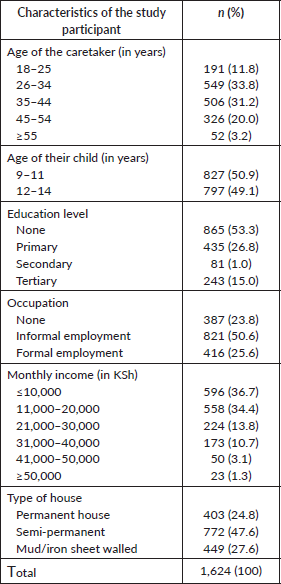
Sociodemographic factors associated with HPV vaccine uptake
The caretakers’ age was significantly associated with HPV vaccine uptake (χ²(4, N = 812) = 10.927, p = 0.027). However, other factors, including the child’s age (χ²(1, N = 812) = 1.515, p = 0.218), the caretaker’s educational level (χ²(3, N = 812) = 1.590, p = 0.662), occupation (χ²(2, N = 812) = 3.492, p = 0.174), monthly income (χ²(5, N = 812) = 6.370, p = 0.272) and housing type (χ²(2, N = 812) = 2.031, p = 0.362), were not significantly associated with vaccine uptake. See Table 2.
Table 2. Relationship between socio-demographic characteristics of the caretakers and their daughters’ HPV vaccination status.
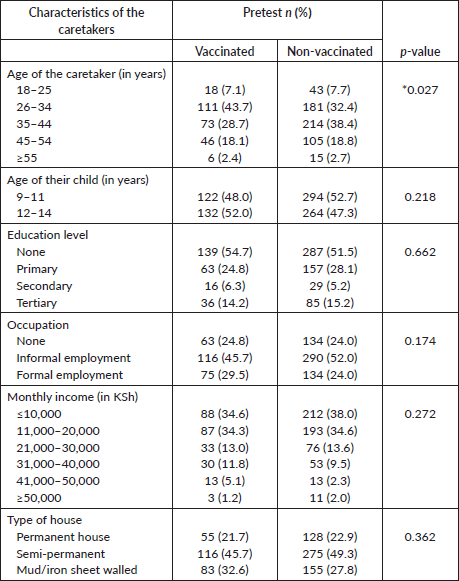
Socio-cultural factors as a predictor of HPV vaccine uptake
Several factors did not significantly influence vaccination uptake. These included seeking permission for vaccination (χ²(2, N = 812) = 1.600, p = 0.449), the individual the caretaker consulted before vaccinating the child (χ²(7, N = 812) = 5.190, p = 0.637), the presence or absence of a spouse during vaccination sessions (χ²(2, N = 812) = 0.095, p = 0.953), reasons for a spouse’s absence (χ²(5, N = 812) = 2.348, p = 0.799), cultural beliefs opposing vaccination (χ²(2, N = 812) = 0.457, p = 0.796) and concerns about vaccines such as fears of infertility or beliefs that vaccines might encourage early sexual activity (χ²(5, N = 812) = 4.489, p = 0.481). Refer to Table 3.
Table 3. Relationship between socio-cultural factors and the HPV vaccination status.

Knowledge of the caretakers as a predictor of HPV vaccine uptake
Caretakers’ understanding of HPV transmission through anal or vaginal intercourse was significantly associated with their decision to vaccinate their children (χ²(2, N = 812) = 10.937, p = 0.004). However, awareness of warts as a sign of HPV infection (χ²(2, N = 812) = 4.742, p = 0.093), knowledge of other symptoms such as vaginal bleeding during or after intercourse (χ²(2, N = 812) = 0.998, p = 0.607) and awareness of causes like having multiple sexual partners or a weakened immune system (χ²(2, N = 812) = 4.282, p = 0.118) did not significantly influence vaccination uptake.
Additionally, caretakers’ understanding of the HPV vaccine’s role in preventing cervical cancer (χ²(2, N = 812) = 0.103, p = 0.950), the necessity of Pap tests as part of HPV prevention (χ²(2, N = 812) = 1.237, p = 0.539), knowledge of the recommended age for HPV vaccination (χ²(2, N = 812) = 0.941, p = 0.625), the availability of free HPV vaccines at public health facilities (χ²(2, N = 812) = 0.973, p = 0.615) and the readiness of public health facilities to provide the vaccine (χ²(2, N = 812) = 2.204, p = 0.332) did not significantly impact caretakers’ decisions. See Table 4.
Attitude of the caretakers as a predictor of HPV vaccine uptake
Caretakers’ belief that the vaccine was expensive (χ²(4, N = 812) = 5.160, p = 0.271), their awareness of its ability to prevent cervical cancer (χ²(4, N = 812) = 4.552, p = 0.336) and misconceptions about the vaccine causing infertility (χ²(4, N = 812) = 1.982, p = 0.739) were not significant determinants. Similarly, caretakers fears about the vaccine causing serious infections (χ²(4, N = 812) = 5.150, p = 0.272), their perceptions of the appropriate age for vaccination (χ²(4, N = 812) = .663, p = 0.956), concerns about pain during administration (χ²(4, N = 812) = 2.408, p = 0.661) and a sense of responsibility to ensure their children were vaccinated (χ²(4, N = 812) = 2.638, p = 0.620) showed no significant association with vaccination decisions. These findings have been summarised in Table 5.
Health facility factors as a predictor of HPV vaccine uptake
Among the 812 caretakers surveyed during the pretest, 448 reported having taken a child for vaccination at some point. However, prior vaccination experience (χ²(1, N = 812) = 0.397, p = 0.529), the time elapsed before a child received prior vaccinations (χ²(3, N = 448) = 2.003, p = 0.572) and missing any vaccine at the facility (χ²(2, N = 448) = 1.803, p = 0.406) did not significantly influence caretakers’ vaccination decisions. Logistical challenges, including missed opportunities due to vaccine shortages, absent health workers, overcrowded facilities or long waiting times, were also not significantly associated with HPV vaccination uptake during the pretest (χ²(3, N = 109) = 1.173, p = 0.759).
Conversely, caretakers’ perceptions of health workers (χ²(3, N = 448) = 8.399, p = 0.038), satisfaction with health facility services (χ²(2, N = 448) = 7.319, p = 0.026) and accessibility factors, such as the distance to health facilities (χ²(3, N = 448) = 19.485, p < 0.001) and transportation costs (χ²(3, N = 448) = 17.609, p < 0.001), were significantly associated with vaccination outcomes. See Table 6.
Regression analysis
Regression analysis revealed that caretakers aged 26–34 were slightly less likely to vaccinate their children against HPV compared to those aged 18–25 (OR = 0.821, 95% CI = 0.340–1.981, p = 0.660), while those aged 35–44 were somewhat more likely (OR = 1.930, 95% CI = 0.790–4.716, p = 0.149). The same lack of a clear pattern emerged among those aged 45–54 (OR = 1.461, 95% CI = 0.568–3.760, p = 0.431) and ≥ 55 (OR = 1.924, 95% CI = 0.407–9.094, p = .409). Such results suggest that age, in isolation, does not appear to shape HPV vaccination decisions consistently. One participant noted,
‘It seems that younger parents, particularly my age group, often hesitate more because they feel uncertain. They also lack the resources or knowledge to make an informed decision about vaccinations. However, older caretakers may have more exposure to the consequences of diseases like cervical cancer, which strengthens their resolve. They also tend to be more decisive about their children’s health.’ (FGD 1, Female 23 years)
Notwithstanding, caretakers who were uncertain if HPV could be transmitted via anal or vaginal route were significantly more likely to vaccinate their children (OR = 2.024, 95% CI = 1.107–3.701, p = 0.022). In contrast, those who negated this statement showed no significant difference in vaccination behaviour (OR = 1.132, 95% CI = 0.690–1.858, p = 0.623). One caretaker lamented,
‘Sometimes, lacking all the facts makes you more cautious, and that caution drives you to take action to protect your child. It is better to be safe than sorry. It is just good to avoid regrets in future for not acting.’ (FGD 2, Male 38 years)
Table 4. Relationship between caretakers’ knowledge levels and their daughters’ HPV vaccination status.

Table 5. Relationship between the caretakers’ attitude towards HPV and HPV vaccine and their daughters’ HPV vaccination status.
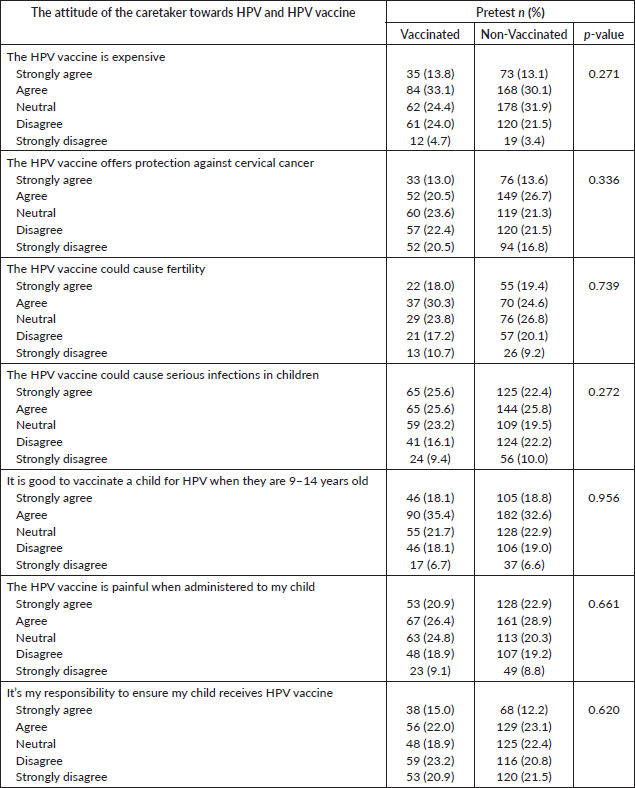
Table 6. Relationship between health system factors and HPV vaccine and their daughters’ HPV vaccination status.
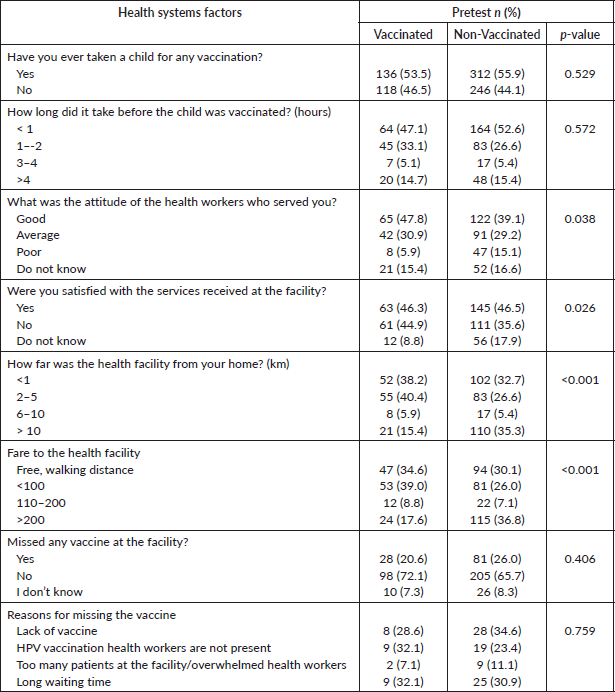
From this finding, it appears that uncertainty about HPV transmission might have encouraged a more cautious approach, prompting caretakers to opt to vaccinate their daughters as a preventive measure. Another parent shared,
‘I didn’t understand all the specifics of HPV transmission, but when the CHVs explained that the vaccine could prevent cervical cancer, I felt it was enough for me to get my daughter vaccinated. When in doubt, I’d rather take the safer route, and the vaccine sounded like the safest option.’ (FGD 3, Female 41 years)
These reflections highlight that limited knowledge about HPV transmission can sometimes propel caretakers to prioritise vaccination as a precaution. The study also observed that caretakers who rated the attitude of health workers as ‘Poor’ were more likely to vaccinate their children (OR = 4.883, 95% CI = 1.834–12.999, p = 0.002) compared to those who rated it as ‘Good.’ One caretaker remarked,
‘The nurses were cold and unhelpful, but I ensured my child got vaccinated. I couldn’t allow a negative interaction with a health worker to prevent me from doing what I thought was best for my child’s future.’ (FGD 4, Female 35 years)
This counterintuitive finding suggests that dissatisfaction with health-worker interactions can sometimes drive caretakers to take proactive measures. Another participant explained,
‘The lack of kindness from health workers sometimes motivates me to get the vaccination done as quickly as possible. I didn’t want to go back to that facility, so I made sure I finished what I started with my child’s vaccine.’ (FGD 5, Female 44 years)
These experiences reveal that health worker attitudes can influence caretakers’ HVP vaccination decisions in ways that may not be clear. Caretakers who rated the attitude of health workers as ‘Average’ showed moderately higher odds of vaccination (OR = 1.704, 95% CI = 0.901–3.223, p = 0.101), though this was not statistically significant. Interestingly, caretakers who were unsure about the health workers’ attitudes were less likely to vaccinate (OR = 0.725, 95% CI = 0.349–1.507, p = 0.389), signalling that clarity and trust in health workers are vital for influencing vaccination choices.
Interestingly, satisfaction with healthcare services had a weaker, yet noticeable, influence on vaccination behaviour. Caretakers dissatisfied with services showed no significant difference in vaccination behaviour compared to those satisfied (OR = 0.969, 95% CI = 0.497–1.890, p = 0.926). However, those who were uncertain about their level of satisfaction (‘Don’t know’) were more likely to vaccinate their children, with borderline statistical significance (OR = 2.476, 95% CI = 0.967–6.342, p = 0.059). One caretaker shared,
‘I was a little bit unhappy with the services, but when it comes to my child’s health, I couldn’t wait around for things to improve. I didn’t feel it was a reason to delay the vaccination.’ (FGD 6, Male 29 years)
Ambiguity regarding satisfaction does not deter caretakers from vaccinating. Rather, it may increase the urgency to address health needs. Another caretaker explained,
‘I wasn’t sure how I felt about the clinic’s services, but I knew the vaccine was important, so I got it for my daughter. Sometimes, even if we have doubts about the system, we can’t let those doubts get in the way of what matters most.’ (FGD 7, Female 32 years)
This highlights how caretakers are often willing to act decisively to protect their children’s health, regardless of uncertainties about healthcare services. Notably, the distance to health facilities did not significantly affect vaccination decisions. Caretakers living 2–5 km from the facility showed slightly lower odds of vaccinating (OR = 0.866, 95% CI = 0.111–6.743, p = 0.891), as did those 6–10 km away (OR = 0.358, 95% CI = 0.048–2.654, p = 0.315). However, those residing more than 10 km away had higher odds of vaccination (OR = 3.136, 95% CI = 0.521–18.881, p = 0.212), though these results did not reach statistical significance. One caretaker reflected,
‘Yes, the health centre is far, but I am determined to try for my child. When it comes to their health, distance is not a concern.’ (FGD 8, Male 25 years)
For many caretakers, the importance of vaccination surpasses the inconvenience of distance. Another participant added,
‘I live in a very remote area, and walking that far can be exhausting, but I’ve learned that my child’s health comes first. If that means travelling a long way, so be it.’ (FGD 9, Female 57 years)
It highlights the significant dedication many caretakers show to ensure their children’s vaccination despite experiencing logistical challenges. Similarly, transportation costs did not significantly impact vaccination decisions. Caretakers who spent < KSh. 100 on transport showed slightly reduced odds of vaccination (OR = 0.742, 95% CI = 0.100–5.489, p = 0.770) compared to those accessing the facility for free. Those spending KSh. 110–200 (OR = 0.515, 95% CI = 0.109–2.437, p = 0.402) or > KSh. 200 (OR = 0.885, 95% CI = 0.158–4.937, p = 0.889) also showed no significant differences. One caretaker shared,
‘Yes, transport is expensive, but if my child were sick because I didn’t vaccinate them, that would be much worse. I find a way to make it work.’ (FGD 10, Female 28 years)
This sentiment reveals that many caretakers prioritise the long-term benefits of vaccination over the short-term financial burdens of transportation. Another participant emphasised,
‘The cost of getting to the clinic isn’t easy for me, but I’m willing to go into debt to have my daughter vaccinated. Health comes first.’ (FGD 11, Female 40 years)
Despite financial constraints, caretakers often find ways to ensure their children receive the necessary vaccinations, illustrating a deep commitment to their children’s well-being. The findings of the binary regression model in this section have been summarised in Table 7 below.
Table 7. Binary regression table of factors associated with HPV vaccine uptake.
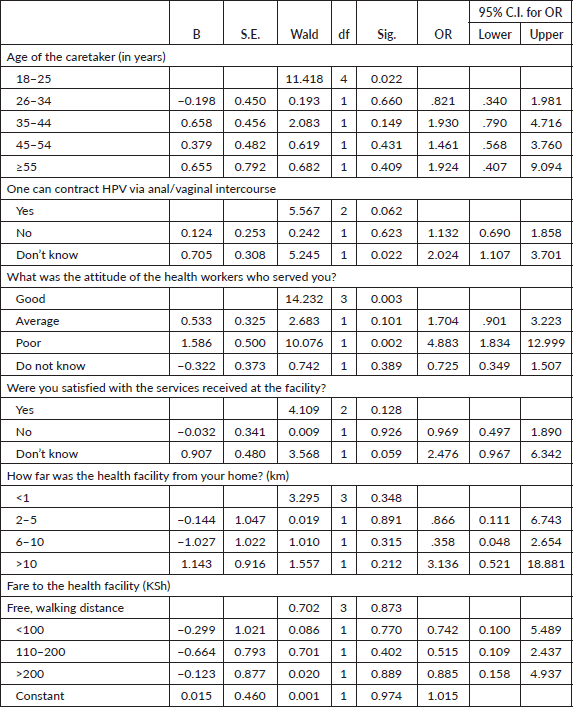
Discussion
The study findings indicate that age alone is not a consistent predictor of HPV vaccination decisions. Younger caretakers aged 26–34 were slightly less likely to vaccinate than those aged 18–25, while older caretakers aged 35–44 showed a moderate increase in likelihood. These trends align with a recent study suggesting younger caretakers often hesitate due to limited knowledge and resources, whereas older caretakers act more decisively, driven by greater awareness of HPV risks [18]. This highlights the need for universally accessible, targeted information to address knowledge gaps across all age groups.
Caretakers uncertain about HPV transmission through vaginal or anal routes were significantly more likely to vaccinate their children. This cautious behaviour supports findings by Liu et al [20] and Gallagher et al [19], which show that emphasising the vaccine’s protective benefits, even without a detailed understanding of transmission, can effectively motivate vaccination. Messaging that focuses on health benefits rather than complex details proves more impactful.
Unexpectedly, negative experiences with health workers sometimes encouraged proactive vaccination behaviours. While negative interactions often erode trust, intrinsic parental motivations can override such barriers [12, 14]. Nonetheless, fostering trust and positive relationships with healthcare providers remains essential for sustainable vaccination programs.
Satisfaction with healthcare services played a weaker, but notable, role. Caretakers expressing ambiguous satisfaction were more likely to vaccinate, prioritising health outcomes over service quality. Similar trends were noted by Kolek et al [18], emphasising that parental commitment to children’s health often transcends dissatisfaction with services.
Logistical challenges, such as distance to facilities and transport costs, did not significantly deter vaccination. Participants living over 10 km from a facility showed higher odds of vaccinating, though the results were not statistically significant. This mirrors findings in a systematic review, where caretakers prioritise their children’s health despite geographic and financial barriers [21]. These findings underscore the resilience and dedication of caretakers in ensuring their children’s well-being.
Conclusion
Several factors influence HPV vaccination decisions among caretakers, including age, knowledge, healthcare experiences and logistical challenges. While older caretakers showed slightly higher vaccination rates, knowledge gaps were a universal concern, emphasising the need for targeted, accessible information.
Simplified messaging focusing on the vaccine’s protective benefits proved more effective than detailed explanations. Negative healthcare experiences occasionally motivated vaccination, though fostering trust with providers remains crucial.
Logistical challenges, such as distance and costs, had minimal impact, highlighting caretakers’ resilience and prioritising their children’s health. These findings underscore the importance of comprehensive, empathetic strategies to support informed vaccination decisions.
Acknowledgments
The authors express their sincere gratitude to the parents in Korogocho ward, Nairobi County, who participated in the study and shared their valuable time and insights. Special thanks go to Dr. David Rocaztle Masinde and Dr. Alexander Munyao Mbeke for their invaluable guidance and feedback throughout the research process. We also acknowledge the support of our families, colleagues and institutions, whose encouragement and resources were essential in completing this study.
Conflicts of interest
All authors affirm that no financial, personal or professional conflicts could have influenced the findings or interpretations. The research was conducted independently, and its conclusions are solely based on the data collected and analysed during the study.
Funding
This study received no specific grant or funding from public, commercial or not-for-profit organisations. All research activities were conducted independently, with resources provided by the authors and their affiliated institutions.
Institutional review
The study was reviewed and approved by the Moi University/Moi Teaching and Referral Hospital Ethics Committee (IREC-628/2023).
Author contributions
Jared Otieno Ogolla conceptualised the study, collected and performed data analysis and drafted the manuscript. Dr David Rocaztle Masinde and Dr Alexander Munyao Mbeke provided oversight for the research process, offering critical guidance during the study design, methodology and data interpretation phases.
References
1. Kamolratanakul S and Pitisuttithum P (2021) Human papillomavirus vaccine efficacy and effectiveness against cancer Vaccines (Basel) 9(12) 1413. https://doi.org/10.3390/vaccines9121413 PMID: 34960159 PMCID: 8706722
2. Staadegaard L, Rönn MM, and Soni N, et al (2022) Immunogenicity, safety, and efficacy of the HPV vaccines among people living with HIV: A systematic review and meta-analysis EClinicalMedicine 52 101585. https://doi.org/10.1016/j.eclinm.2022.101585 PMID: 35936024 PMCID: 9350866
3. Nairobi County Government (2017) County Development Integrated Plan 2018 - 2022. Nairobi, Kenya: Nairobi County Government.
4. Elfversson E, Höglund K, and Mutahi P, et al (2024) Insecurity and Conflict Management in Urban Slums: Findings from a Household Survey in Kawangware and Korogocho, Nairobi. Kenya: Centre for Human Rights and Policy Studies.
5. Hussein SN, Omoto AL, and Audi G (2023) Urban slums morbidity spectrum: a cross sectional study on Korogocho Slum, Kenya Asian J Res Infect Dis 14(4) 103–112 https://doi.org/10.9734/ajrid/2023/v14i4313
6. Maina BW, Orindi BO, and Sikweyiya Y, et al (2020) Gender norms about romantic relationships and sexual experiences among very young male adolescents in Korogocho slum in Kenya Int J Public Health 65(4) 497–506. https://doi.org/10.1007/s00038-020-01364-9 PMID: 32270236 PMCID: 7275025
7. Gakii MJB, Nyavanga EJ, and Masita P (2023) Social-cultural factors associated with common mental health disorders among pregnant and parenting teenagers: a case study of Korogocho Slums, Nairobi County, Kenya Int J Trop Dis Health 44(12) 24–33. https://doi.org/10.9734/ijtdh/2023/v44i121444
8. Asgedom YS, Kebede TM, and Seifu BL, et al (2024) Human papillomavirus vaccination uptake and determinant factors among adolescent schoolgirls in sub-Saharan Africa: a systematic review and meta-analysis Hum Vaccin Immunother 20(1) 2326295. https://doi.org/10.1080/21645515.2024.2326295 PMID: 38505959 PMCID: 10956624
9. Moucheraud C, Ochieng E, and Ogutu V, et al (2024) Intervention-amenable factors associated with lack of HPV vaccination in Kenya: Results from a large national phone survey Vaccine 42(26) 126410. https://doi.org/10.1016/j.vaccine.2024.126410 PMID: 39388933
10. Ochomo EO, Tonui P, and Muthoka K, et al (2024) ‘Addressing HPV vaccine hesitancy: unveiling concerns and building trust’ perspectives of adolescent girls and parents in Kisumu County, Kenya Ecancermedicalscience 18 1735. https://doi.org/10.3332/ecancer.2024.1735
11. Zheng L, Wu J, and Zheng M (2021) Barriers to and facilitators of human papillomavirus vaccination among people aged 9 to 26 years: a systematic review Sex Transm Dis 48(12) e255–262. https://doi.org/10.1097/OLQ.0000000000001407 PMID: 33783412 PMCID: 8594509
12. Kutz JM, Rausche P, and Gheit T, et al (2023) Barriers and facilitators of HPV vaccination in sub-saharan Africa: a systematic review BMC Public Health 23(1) 974. https://doi.org/10.1186/s12889-023-15842-1 PMID: 37237329 PMCID: 10214362
13. Osaghae I, Chido-Amajuoyi OG, and Khalifa BAA, et al (2023) Barriers and determinants of consistently offering HPV vaccination by healthcare facilities Hum Vaccin Immunother 19(2) 2264596. https://doi.org/10.1080/21645515.2023.2264596 PMID: 37846730 PMCID: 10583630
14. MacDonald SE, Kenzie L, and Letendre A, et al (2023) Barriers and supports for uptake of human papillomavirus vaccination in Indigenous people globally: a systematic review PLOS Global Public Health 3(1) e0001406. https://doi.org/10.1371/journal.pgph.0001406 PMID: 36962871 PMCID: 10021254
15. Mukami M (2021) VaccinesWork. Filling the vaccine gap in Kenya. Available from: https://www.gavi.org/vaccineswork/filling-vaccine-gap-kenya
16. Kanja LW, Karimi PN, and Maru SM, et al (2021) Factors that affect vaccines availability in public health facilities in Nairobi City County: a cross-sectional study Pan African Med J 38 72. https://doi.org/10.11604/pamj.2021.38.72.21580
17. Githiri G, Ngugi R, and Njoroge P, et al (2016) Nourishing livelihoods: recognising and supporting food vendors in Nairobi’s informal settlements. Nairobi: IIED’s Human Settlements Group. Available from: https://www.iied.org/10762iied
18. Kolek CO, Opanga SA, and Okalebo F, et al (2022) Impact of parental knowledge and beliefs on HPV vaccine hesitancy in Kenya-findings and implications Vaccines 10(8) 1185. https://doi.org/10.3390/vaccines10081185 PMID: 35893833 PMCID: 9332201
19. Gallagher KE, Kadokura E, and Eckert LO, et al (2016) Factors influencing completion of multi-dose vaccine schedules in adolescents: a systematic review BMC Public Health 16 172. https://doi.org/10.1186/s12889-016-2845-z PMID: 26895838 PMCID: 4759915
20. Liu CR, Liang H, and Zhang X, et al (2019) Effect of an educational intervention on HPV knowledge and attitudes towards HPV and its vaccines among junior middle school students in Chengdu, China BMC Public Health 19(1) 488 https://doi.org/10.1186/s12889-019-6823-0 PMCID: 6498581
21. Mseke EP, Jessup B, and Barnett T (2024) Impact of distance and/or travel time on healthcare service access in rural and remote areas: a scoping review J Transp Health 37 101819. https://doi.org/10.1016/j.jth.2024.101819






